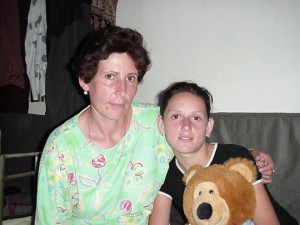
Guest Blog: UNT Professors in Kosovo Days 3 and 4
Jun 11, 2010
Day Three in Kosovo:
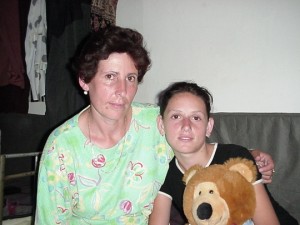
2000--Vlora and her mother Florije one year after the war, living in the Brickcamp IDP Camp
Today we walked. And walked. And walked. We walked all through “old town” in Gjakove and explored. The streets in that section of town are made of stone pavers, which we love, and the buildings are weathered from history. The people of Gjakove have worked hard to restore the buildings damaged during the war yet everywhere you turn is another reminder of what the people here have been through.
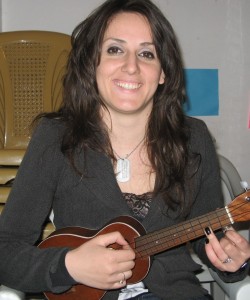
Vlora, SMF Volunteer, (whose family still lives in an IDP camp), 2009
Although we met Vloravery briefly earlier this trip, we were very lucky to get to spend a few hours with her today. Vlora was kind in answering many questions about Kosovo culture and her life while taking us on a hike.
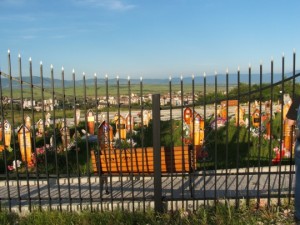
Cemetery for Massacre Victims
We visited a Teqe and learned about prayer rituals and saw the site where 60 men were killed in a massacre during the war. The cemetery features a wall with photos of the people killed and the faces looking out were haunting. We noticed a man wearing a Yale sweatshirt….very much like the one Jennifer brought on this trip. We were left to wonder why, with so much in common among people, is there so much violence?
Day Four in Kosovo:
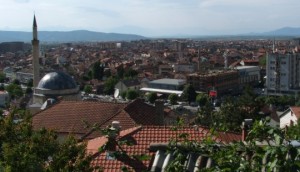
City of Prizren
Burim was very kind and gave us directions and an Albanian cheat sheet so that we could take a bus and visit the city of Prizen today. Prizen is a very old city with a great deal of history. The Turkish bath was closed but we did get to view a mosque and the local museum. In some countries Jennifer would not be allowed in the mosque or relegated to a women’s viewing area, but the culture in Kosovo is more inclusive between prayer times. A school field trip was at the museum and we couldn’t help but notice that teenagers in Kosovo behave very much like teenagers in America when they are on a field trip.
It´s Thursday evening. Ten volunteers, teenagers trained by Liz and Burim to lead music classes, have come to the house for training. Many are seeing Liz for the first time in months and their joy is obvious: one girl jumps up at the door, a radiant smile, and offers Liz an emphatic hug. All of them are clearly thrilled to be back, an immediate connection to Liz, this place and its memories. Over the next hour, between stories and updates, music and a lot of laughter, they map out their strategy for bringing a music program to a nearby village, Skivjan.
Watching them interact, it’s immediately clear what makes the SMF program special, they are sitting and talking and laughing. If you go by statistics alone, you might be forgiven for assuming you’d be met with a grim impression: a recent survey found PTSD to be rampant in Kosovo. Yet these kids give no hint of the country’s dark past.
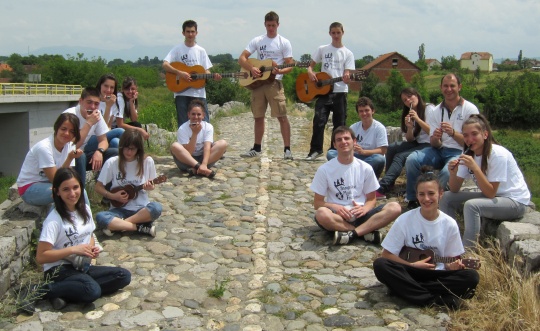
Some Youth Volunteers Posing on Centuries-old Bridge, May 2010. Vlora is sitting in front of left guitar player.
In meeting the SMF volunteers, it is hard not to come away impressed and humbled and uplifted. In many ways, they are like teenagers anywhere: they laugh a lot, they love music, they enjoy being with their friends in the program. But there is also something unique going on: they greet you with a confidence and maturity that sometimes seems rare in their American counterparts. They care a lot about each other and it’s immediately apparent that they care deeply about what they are doing with SMF. They love the children they teach, and they love teaching, and they are not shy in admitting this. They describe how music offers children a place to learn a new skill, how it builds their self-esteem, how it gives the younger children a distraction and a place to have fun.
In any country, these volunteers would be an impressive group. Yet they are all the more impressive considering the context: they were young when the war happened, some as young as 5, others as old as 10, yet each one can vividly recall the war.In subsequent conversations and interviews, we learn about this darker past, about being forced to leave their homes and hide in basements, about the sound of bombs exploding and Serbians firing their weapons into buildings, about long hikes across the border to Albania or further. Some recall watching their parents being threatened with imprisonment or worse, others about seeing people killed or hurt, bodies next to the road, Serbians firing into a crowd. Almost everyone knows someone who was taken and never seen again, a cousin, a family friend, sometimes a father or an uncle. It is hard to hear these stories, yet these kids show bravery and compassion in the face of what would undermine most. Perhaps because it was so common, perhaps because they were so young, there is forgiveness and compassion in their descriptions. You do not hear bitterness, you do not hear calls for revenge. These are teenagers, yet they show a maturity and wisdom many adults never develop. We feel humbled and glad to know them.
More to come!!